An at-home bodyweight back and biceps workout helps build strength and muscle mass in the lats, lower back, rhomboids, both heads of the biceps, and forearms.
The combination of bodyweight back and bicep exercise helps to increase your muscle strength and endurance in the back and arm.
The pairing of back and bicep muscles is as old as pull-ups, chin-ups, and row exercises. The back muscle is the main targeted muscle in most pull-up exercises, and the bicep and rear delt are crucial synergistic muscles.
They are very common in today’s bodybuilding training regimens.
So, whether you are a beginner or an advanced lifter, here we discuss the back and bicep workout routines and exercises that you can do at home without equipment to build muscle mass and strength.
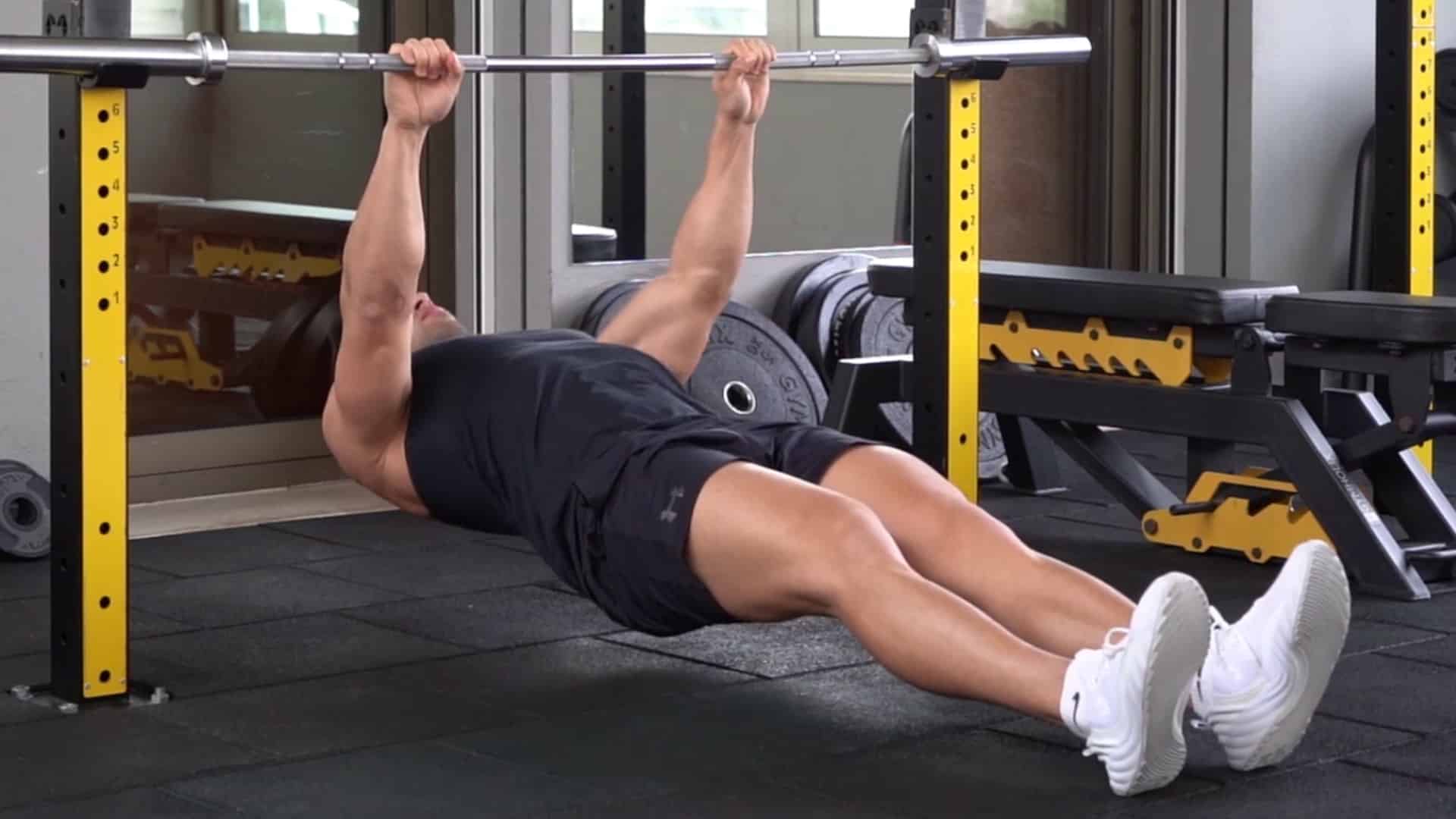
- Benefits of Bodyweight Back and Bicep Workouts at Home
- 10 Best Bodyweight Back and Bicep Exercises for Home Workouts
- 1. Inverted Row
- 2. Pull-Up
- 3. Superman
- 4. Good Morning
- 5. Bird Dog
- 6. Chin Up
- 7. Bodyweight Bicep Curl
- 8. Towel Bicep Curls
- 9. Isometric Chin-Ups
- 10. Reverse Grip Push-Up
- Back And Bicep Workout Routine For Beginner
- Back and Biceps Workout Plan at Home Without Equipment.
- Bodyweight Back And Bicep Superset Workout Plan
- FAQs
- How can I train my back and biceps at home?
- How long should a back and bicep workout be
- Can I get a strong back and biceps by working out at home?
- References
Benefits of Bodyweight Back and Bicep Workouts at Home
After years of bodyweight training, I’ve realized that you don’t need to do complex exercises or routines to build strength and muscle. In my experience, simplicity is the key to growing stronger and more muscular.
Bodyweight exercises are typically considered beginner-friendly workouts, but with the variations and modifications, you can make them challenging, even if you are an advanced lifter. They are perfect for the at-home exerciser with limited space.
However, it does require a tremendous amount of work, patience, and time.
Training your back and biceps in the same workout is a time-tested approach. People have been doing it for decades for a very straightforward reason: it works.
During a compound back workout, many targeted muscles work together with other Synergistic and stabilizer muscles to function. This meta-analysis found that compound exercises were more effective at building muscle mass than isolation exercises.
When doing a pull-up, the back is the main targeted muscle. However, many other Synergistic and stabilizer muscles act in this motion, such as the Biceps brachii, rear deltoid, and traps.
10 Best Bodyweight Back and Bicep Exercises for Home Workouts
Here are 10 bodyweight exercises to help you build back and biceps without iron. You can use these as part of a regular workout or as a standalone circuit.
1. Inverted Row
The inverted row, or bodyweight row, is easier to perform because it puts your body horizontally.
It also works the back, shoulder, and biceps muscles from a different angle and improves scapular retraction.
You could also perform the inverted row at home by lying under a chair, holding the chair’s sides, and pulling yourself up.
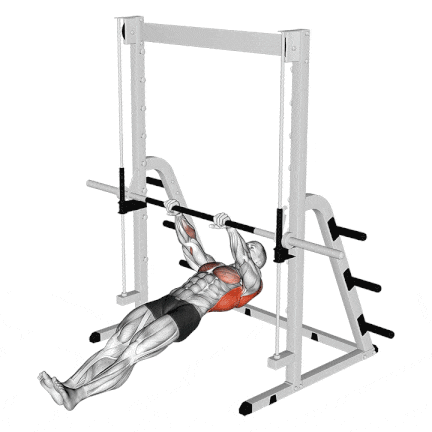
How To Do
- Adjust the height of the chair or bar so that they are slightly higher than arm’s length from the floor.
- Lie under the bar with your legs and body straight.
- Hold the bar with an overhand grip that is a little wider than shoulder width.
- Tighten your core, and keep your body stiff from your head to your toes.
- Exhale as you pull your chest to the bar.
- Hold for a count of two and squeeze your back muscles.
- Inhale as you lower your body until your arms and shoulders are fully extended. Repeat.
- Make sure you go down completely. Lower your body until the arms are fully extended, and then raise your body until the chest touches the bar.
2. Pull-Up
Pull-ups are one of the best bodyweight exercises for building upper body strength. They require little equipment and work many muscles simultaneously. They are challenging for both beginners and experienced athletes.
It increases the strength, thickness, and width of your back, specifically your lats. The lats widen the back and form the “V” in the upper back.
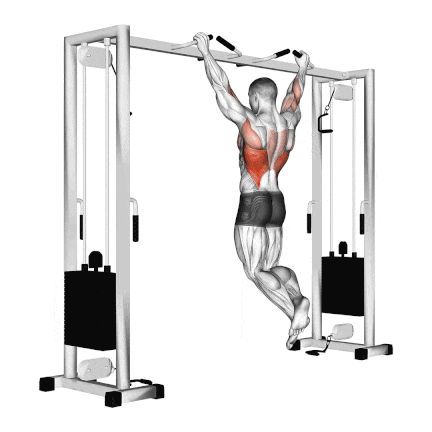
How To Do
- Grab the pull-up bar with an overhand grip (palms facing away from you).
- Hang from the bar with your arms fully extended and your chest high, while exaggerating the arch in your lower back.
- Pull yourself up by squeezing your shoulder blades together and contracting your lats until your chin passes the bar.
- Hold the contraction at the top for a second before slowly lowering yourself back to the starting position.
- To decrease bicep involvement, use a thumbless grip.
Know More: 25 Different Types Of Pull Ups And Chin Ups (Variations)
3. Superman
Superman is one of the best back exercises that you can do at home without equipment. It strengthens your upper and lowers back muscles.
If done regularly, the Superman may help alleviate back pain that is related to weak back muscles. You should add this bodyweight exercise to your back workout routine to strength the lower back. It also works on your glutes and your hamstrings.
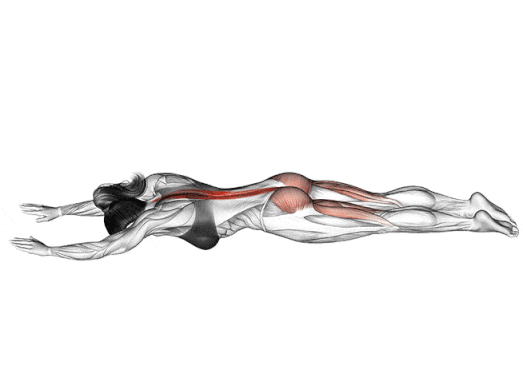
How To Do
- Lie down with your stomach flat on the ground. Extend your arms in front of you, with your palms facing downwards.
- Lift your head, raise your arms and chest as far as possible off the ground.
- Lift your thighs off the ground by bending your legs. (Try to make a big “U” with your back.)
- At this point, you should feel your back muscles, glutes, and hamstring muscles tightening up.
- Beginners start holding for only 5 or 10 seconds and then work your way up to 30 seconds in future workouts.
- Then, lower yourself back to the starting position.
4. Good Morning
It is known as a good morning because of the movement in the erector spinae, which resembles the rise out of bed when it comes to stretching.
The erector spinae muscles of the lower back work isometrically to keep the spine in an extended position, while the hamstrings and gluteus maximus work isotonically to perform hip extension.
To allow your lower back to adapt to the good morning exercise, start with a lightweight or with a stick and gradually add more weight.
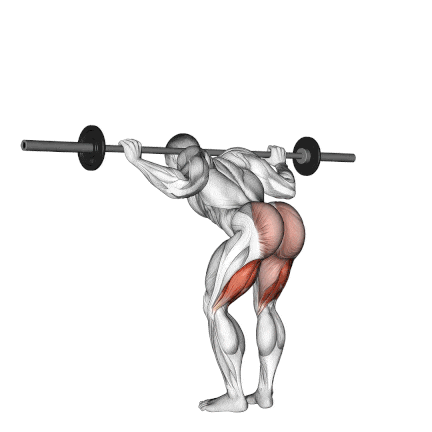
How To Do
- Take a stick, stand with it on the back of your shoulders, and grasp it at each side. (beginner do bodyweight version.)
- With your knees slightly flexed and your back and neck in a neutral position, breathe in and slowly flex your hips. Lower your torso until it is close to or fully horizontal.
- It is recommended that the lifter avoid rounding the back or rotation (twisting) at any point during the movement.
- Breathe out as you raise your torso to the starting position by extending your hips.
- Keep the movement slow, the form strict, and the weight light.
Know More: 12 Best Lower Back Strengthening Exercises To At Home
5. Bird Dog
The bird dog is a very effective exercise for training the abdominal and lower back muscles. It also works other muscles, such as the glutes.
The bird dog is a great exercise for building a stable trunk. Its name comes from the position that alternates between sitting on hands and knees (dog) and stretching the arms and legs (bird).
A study has found that dead bug exercise was more efficient in improving core and lower back strength, endurance, and flexibility.
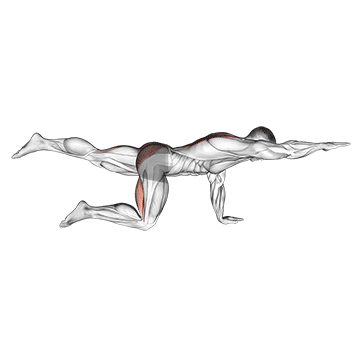
How To Do
- Get into a kneeling position with your hands placed in front of your body at shoulder width.
- Raise one hand and the opposite knee slightly off the floor while contracting your abs. You are now balancing on the other knee and hand.
- Now, extend your arm and leg as far as they will go. Try to make a straight line from your hand to your foot.
- Hold this position for about 10 seconds and then return to the starting position.
- Repeat the exercise with the other side.
6. Chin Up
Pull-ups and chin-ups are often used interchangeably, but they do have some differences. The main difference between the two exercises is the grip used.
During chin-up, the palms face toward the body (underhand or supinated grip). This grip targets the biceps more than the back and shoulders.
Since you are lifting your body weight, the biceps are often exposed to loads heavier than they can lift with a barbell.
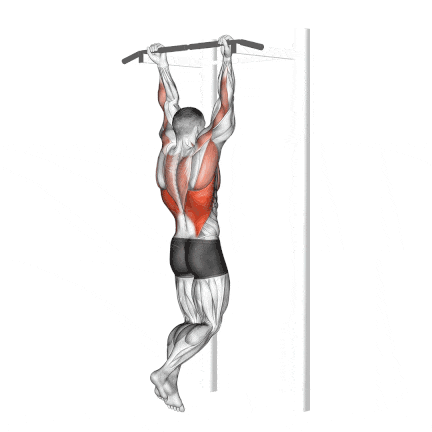
How To Do
- Grasp a pull-up bar with an underhand grip and hands shoulder-width apart or slightly narrower.
- Brace your abdominal muscles to create tension throughout your body. This will increase your stability as you move.
- Pull yourself up from your stationary position until your chin is above the bar. Your legs should be still, and your neck should be neutral.
- Retract your shoulder blades and pull your body up until your chin aligns with the bar.
- Pause at the top for one to two seconds, with the biceps under maximum tension. Slowly lower to the start position.
- Lower to almost full extension of the elbow, but avoid locking out completely.
Know More: Pull Ups Vs Chin Ups: The Ultimate Comparison
7. Bodyweight Bicep Curl
The bodyweight bicep curl is a good exercise for building arm muscle and strength. These exercises require no equipment; only your bodyweight is needed.
We sometimes lack access to equipment, but that’s not an issue with the bicep leg curl, as you only require your arms and legs.

How To Do
- Begin by sitting on a chair as close to the edge as possible. Then, place your right hand under your left thigh at the crease between your hamstrings and calves.
- Slowly curl your right up as high as you can. Exhale during this portion of the exercise.
- Hold for a couple of seconds.
- Then, slowly lower your leg back down so your foot is just above the ground. Inhale during this portion of the exercise.
- Repeat for the desired number of reps. Repeat the exercise with your left arm.
8. Towel Bicep Curls
You can perform this exercise by standing with your back against the wall, grabbing both ends of a towel, and putting one foot on a sling.

How To Do
- Stand with your knees slightly bent and your abs tucked in. Your non-dominant arm should be down at your side, with your palm facing forward. Put your opposite palm over your wrist.
- Make a fist with your working hand and execute a biceps curl with that arm while resisting it with the other.
- Shift the resistance on the way, so your palm pushes the working arm down. Return to the starting position.
- Finish your set, then repeat, with the other arm doing the work.
9. Isometric Chin-Ups
The Isometric means that the muscles don’t get longer or shorter; they stay the same shape.
Isometric biceps holds are like holding bags of groceries with your elbows bent at 90-degrees. In this position, your biceps are fully flexed, holding the bags stationary.

How To Do
- Place your hands on the pull-up bar with your palms facing you and your hands about shoulder distance apart.
- Pull yourself until your chin is over the bar. If you cannot do a chin-up, you can still do this exercise by using a chair or step to jump.
- Your chin should be above the bar. Hold for 5 seconds, then lower to 90 degrees and hold for 5 seconds, then lower again to just before the bottom.
- Repeat for the desired number of reps.
10. Reverse Grip Push-Up
The reverse grip push-up is a fun and great variation of the standard push-up. You do it with your fingers facing your feet (your palms outward).
Many consider it the “bicep push-up” because of its hand position, which emphasizes the biceps a little more than the standard push-up.

How To Do
- Get down into a press-up position with your hands placed so your fingers point toward your toes.
- Take a big breath in and slowly start to bend your elbows. Do not let your elbows move outwards (away from your body).
- Lower yourself until you are about an inch from the floor. Pause the movement when you are at the bottom for a second.
- Push through your palms like you would try to push the floor away from yourself, extending the arms but maintaining a slight bend in the elbow.
- Repeat this for however many repetitions you wish to perform.
Know More: 25 Different Types Of Push Ups (Best Variations)
Back And Bicep Workout Routine For Beginner
Note: Do you remember that the biceps are involved in most back exercises? If you were to do 10-20 sets for the back each week, you would not also need 10-20 sets for the biceps because the biceps would already receive a lot of secondary volume while training the back.
Below, you will find an easy-to-understand back and bicep workout routine for beginners. This program consists of the primary back movements and will help you build a good base of muscle mass and strength.
| Exercise | Sets | Reps |
|---|---|---|
| Inverted Row | 4 | 8-12 |
| Pull-Up | 4 | 10-12 |
| Superman | 3 | 8-10 |
| Bodyweight Curl | 4 | 8-10 |
| Bird Dog | 3 | 8-10 |
Back and Biceps Workout Plan at Home Without Equipment.
| Exercise | Sets | Reps |
|---|---|---|
| Inverted Row | 4 | 8-10 |
| Pull-Up | 3 | 10-12 |
| Superman | 3 | 6-8 |
| Chin Up | 4 | 8-10 |
| Towel Curl | 3 | 10-12 |
Bodyweight Back And Bicep Superset Workout Plan
- Inverted Row: 4 sets of 6-8 reps, superset with,
- Chin Up: 4 sets of 6-8 reps.
- Bird Dog Exercise: 3 sets of 6-8 reps, superset with,
- Towel Bicep Curls: 3 sets of 8-10 reps.
- Superman: 3 sets of 4-6 reps, superset with,
- Reverse Grip Push-Ups: 3 sets of 6-8 reps.
FAQs
How can I train my back and biceps at home?
All the above exercises are the best options for a back and bicep bodyweight workout at home. Building your back and biceps is a sign of dominance, and having a V-taper back and big Gun is accomplished through these exercises.
How long should a back and bicep workout be
A good target length for a back and bicep workout is 45-60 minutes. This allows enough time to adequately work the major muscles of the back and biceps through compound and isolation exercises.
Can I get a strong back and biceps by working out at home?
Absolutely. You can build a strong back and biceps at home with the right exercises and consistency. Focus on compound movements like pull-ups, rows, chin-ups, and targeted bicep curls, and you’ll see results.
References
- Paulo Gentil, Saulo Soares, and Martim Bottaro Single vs. Multi-Joint Resistance Exercises: Effects on Muscle Strength and Hypertrophy. Asian J Sports Med. 2015 Jun
- Strength and Conditioning Journal: October 2017 – Volume 39 – Issue 5 – p 33-35. Large and Small Muscles in Resistance Training: Is It Time for a Better Definition?
- J Strength Cond Res. 2020 May;34(5):1254-1263. Varying the Order of Combinations of Single- And Multi-Joint Exercises Differentially Affects Resistance Training Adaptations.

Manish is a NASM-certified fitness and nutrition coach with over 10 years of experience in weight lifting and fat loss fitness coaching. He specializes in gym-based training and has a lot of knowledge about exercise, lifting technique, biomechanics, and more.
Through “Fit Life Regime,” he generously shares the insights he’s gained over a decade in the field. His goal is to equip others with the knowledge to start their own fitness journey.
